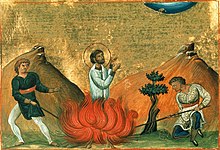Abibus of Edessa
firemen; Syria (region), Syrians |
|---|
Abibus of Edessa (
Biography

Early life
Abibus was born in Edessa (modern-day
Decree by the Emperor
The Emperor made a
Torture and discourse with the Governor
During his multiple days of torture, Abibus was subjected to the scourging and combing of five men. When threatened with more gruesome torture by the governor, the saint is quoted as saying: "As a tree that is watered bears fruit, so is my spirit strengthened by torment", frustrated by his powerless efforts, the Governor replied: "Does your faith teach you to hate your own body?", to which Abibus replied: "We do not hate this material body, but we rejoice in the spiritual reality; the suffering of this present time is not worth comparing with the glory that awaits those who embrace Christ."[5] The governor mockingly replied: "Is this suffering you endure glorious?" Abibus responded: "It is not for you to ask questions, for your unbelief is not worthy to hear the answers to them, as the Scripture teaches us: do not cast that which is holy to dogs, nor pearls before swine."
Execution, burial and hagiographical tradition
Abibus was sentenced to be
After the flames were extinguished, his body was found undamaged by his mother and relatives. According to the
In Euphemia and the Goth
Brief summary
Euphemia and the Goth is a
The Goth takes Euphemia to his home only to have her enslaved to his Gothic wife. The Goth tells her to do with the baby as she wishes. Euphemia's infant is then killed by the jealous wife, who put poison in its food. When Euphemia does the same to her, she is shut in the tomb of the wife, but after praying for the intercession of Habib, she miraculously wakes up back next to tomb of Habib and returns to her mother Sophia in Edessa.
The Goth sometime later returns to Edessa and is confronted by Euphemia and Sophia. Both make an
Feast and other traditions

Feast day
Abibus' individual
Traditions
In
References
- ^ "Lives of the Saints". www.holy-transfiguration.org. Retrieved 2023-09-14.
- ^ a b "Holy Martyrs and Confessors Gurias, Samonas, and Habibus, of Edessa". www.oca.org. Retrieved 2023-09-14.
- ^ Bishop Grigorios of Mesaoria. "Memory of Holy Martyrs and Confessors Gurias, Samonas, and Abibus of Edessa", Orthodox Times, November 15, 2019
- ^ Holy Martyrs and Confessors Gurias, Samonas and Abibus, of Edessa Retrieved on 20 Feb 2018
- ^ a b Holy Martyrs GURIA, SHAMUNA, and HABIB of Edessa (November 15), retrieved 2023-09-14
- ^ Monks of Ramsgate. "Abibus". Book of Saints, 1921. CatholicSaints.Info. 2 September 2016
 This article incorporates text from this source, which is in the public domain.
This article incorporates text from this source, which is in the public domain.
- ^ Antiochene (2013-03-29). "Habib-i Neccar and Sham'un". Antiochene. Retrieved 2023-09-15.
- ^ Gorgias Encyclopedic Dictionary of the Syriac Heritage website
- ^ The Cult of Saints in Late Antiquity website
- ^ Great Synaxaristes: (Greek) Ὁ Ἅγιος Ἄβιβος ὁ Μάρτυρας ὁ νέος. 2 Δεκεμβρίου. ΜΕΓΑΣ ΣΥΝΑΞΑΡΙΣΤΗΣ.]
Sources
- Holweck, F. G. A Biographical Dictionary of the Saints. St. Louis, MO: B. Herder Book Co. 1924.
